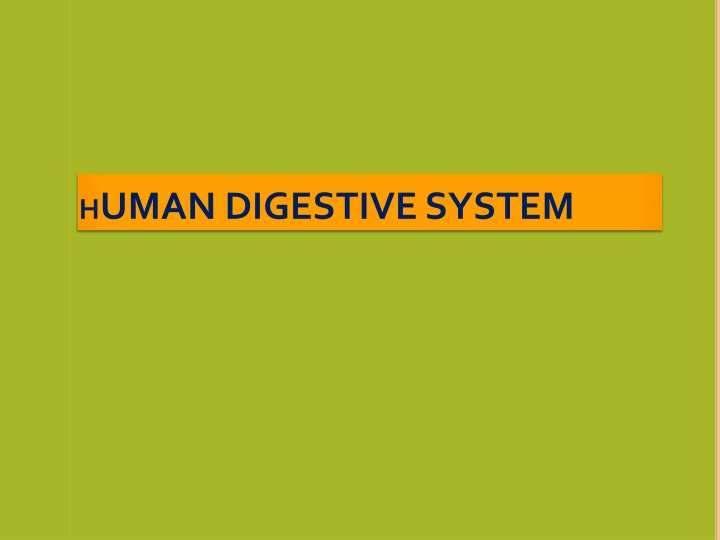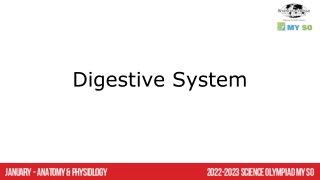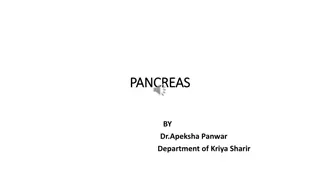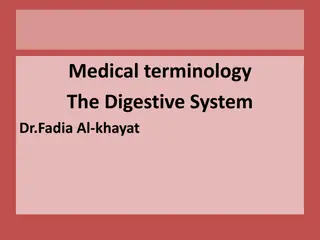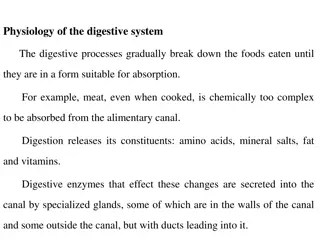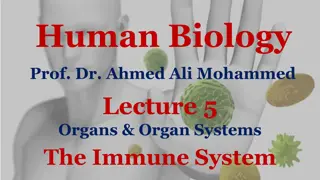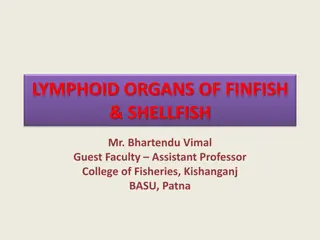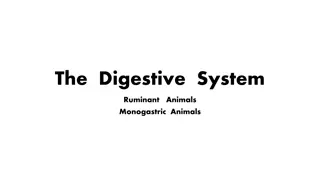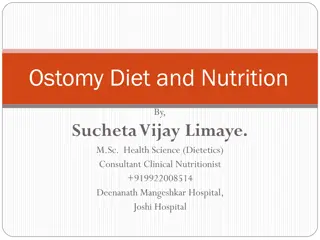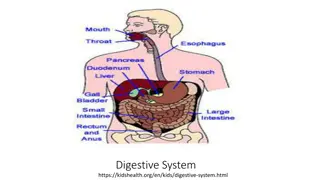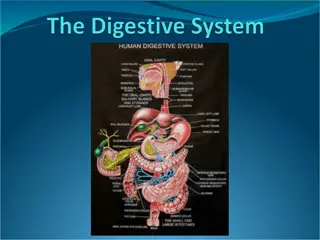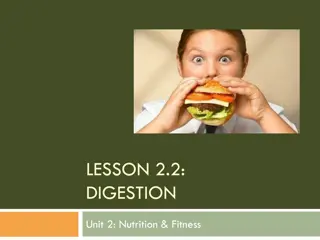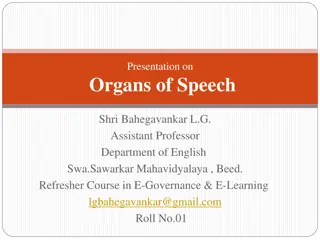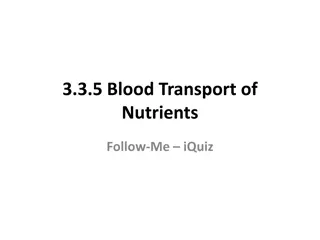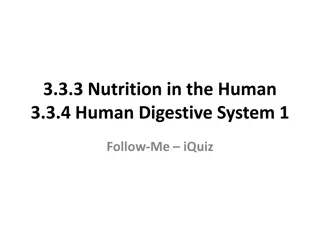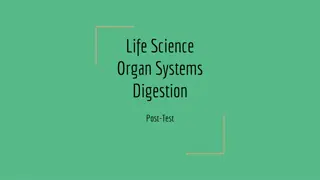Human Digestive System: Major Organs and Functions
The human digestive system is a complex network of organs working together to break down food into smaller molecules for absorption. It consists of major organs like the mouth, esophagus, stomach, small intestine, and large intestine, along with accessory organs such as the liver, gallbladder, and pancreas. Each organ plays a crucial role in the process of digestion, from mechanical breakdown in the mouth to chemical digestion in the stomach. Understanding how these organs function can provide insights into maintaining good digestive health.
Download Presentation

Please find below an Image/Link to download the presentation.
The content on the website is provided AS IS for your information and personal use only. It may not be sold, licensed, or shared on other websites without obtaining consent from the author.If you encounter any issues during the download, it is possible that the publisher has removed the file from their server.
You are allowed to download the files provided on this website for personal or commercial use, subject to the condition that they are used lawfully. All files are the property of their respective owners.
The content on the website is provided AS IS for your information and personal use only. It may not be sold, licensed, or shared on other websites without obtaining consent from the author.
E N D
Presentation Transcript
OVERVIEW Major organs Mouth Esophagus Stomach small intestine large intestine Acessory organs: Liver gall bladder Pancreas.
HUMAN DIGESTIVE SYSTEM The process of reducing food into smaller molecules that can be absorbed into the body Digestive system consists of 2 major parts Major organs Mouth Esophagus Stomach small intestine large intestine. Acessory organs: Liver Gall bladder Pancreas.
MAJORORGANS THEMOUTH pH: 7 The first part of the digestive system the entry point of food. Structures in the mouth that aids digestion Teeth cut, tear, crush and grind food. Salivary glands produce and secrete saliva into the oral cavity. saliva moistens the food contains enzymes (ptyalin or salivary amylase) begins digestion of starch into smaller polysaccharides. Function: Mechanical digestion. increasing surface area for faster chemical digestion.
The Esophagus a tube connecting the mouth to thestomach running through the Thoraciccavity. Location: lies behind windpipe (Trachea). o The trachea has as an epiglottis o preventing food from entering the windpipe, o moving the food to the esophagus while swallowing.
Food travels down the esophagus, through a series of involuntary rhythmic contractions (wave-like) called peristalsis. Function: The lining of the esophagus secretes mucus Lubricating to support the movement of food.
ESOPHAGEALSPHINCTER: bolus reachesthe stomach must pass through a muscular ringed valve called the esophageal sphincter (Cardiac Sphincter). Function: prevent stomachacids from back flowing into the esophagus.
STOMACH J-shaped muscular sac Has inner folds (rugae) Increasing surface area of the stomach. Function: Stomach performs mechanical digestion HOW By churning the bolus and mixing it with the gastricjuices secreted by the lining of the stomach. GASTRIC JUICES HCl, salts, enzymes, water and mucus. HCL helps break down of food and kills bacteria thatcame along with the food. The bolus is now called Chyme.
ENZYMES IN STOMACH: Acidic environment HCl secreation kill any microbes that are found in thebolus, creating a pH of 2. Mucus prevents the stomach from digestingitself. Pepsin secreation responsible for initiating the breakdown of proteins (in)food. hydrolyzes proteins to yield polypeptides.
Pyloric sphincter: chyme moves from the stomach to the small intestine. It passes through a muscular ringed sphincter called the pyloric sphincter.
STOMACH DOES NOT DIGEST ITSELF WHY? Protective Mechanism: 3 protective mechanisms. 1. First the stomach only secretes small amounts ofgastric juices until food ispresent. Second the secretion of mucus coats the lining ofthe stomach protecting it from the gastricjuices. The third mechanism is the digestive enzyme pepsinis secreted in an inactive protein called pepsinogen. Pepsinogen is converted to pepsin in the increased presence of hydrochloric acid (pH1). 2. 3.
SMALL INTESTINE Responsible for the complete digestion of all Macromolecules and the absorption of their component molecules E.g Glucose Glycerol Fatty acids Amino acids Nucleotides
PARTS OF SMALL INTESTINE The small intestine is made up of three parts Duodenum Jejunum ileum
1.DUODENUM The first part is the duodenum, u-shaped organ. approximately 30 cm in length. This area completes most of the digestion processes. Enzymes are secreted into the duodenum form the pancreas and the gall bladder. The duodenum is lined by folds of tissue called villi. The villi are covered by fine brush-like microvilli. These folds increase the surface area of the small intestine increase the rate of absorption.
2.JEJUNUM The jejunum is approximately 2.5 m long. Although some digestion is completed here, it has more villi and microvilli; its role is absorption of nutrients. 3.Ileum o The ileum, is approximately 3m long. o has fewer villi and microvilli than the other two parts. o Although absorption also occurs here, it is responsible for pushing the waste materials into the large intestine.
FUNCTIONS OF THE SMALL INTESTINE 90% of the digestion and absorption of food occurs other 10% taking place in the stomach and large intestine. The main function of the small intestine is absorption of nutrients and minerals from food. Digestion of proteins Proteins, peptides and amino acids are acted upon by enzymes such as trypsin and chymotrypsin, secreted by the pancreas. This breaks them down to smaller peptides.
DIGESTION OF LIPIDS Enzymes, like lipases secreted from the pancreas, act on fats and lipids in diet. Lipase can break them into the smaller parts that can enter the intestinal villi for absorption. Digestion of carbohydrates Carbohydrates are broken down to simple sugars and monosaccharides like glucose. Pancreatic amylase breaks down some carbohydrates to oligosaccharides as well. Some carbohydrates and fibers pass undigested to the large intestine where they may, depending on their type, be broken-down by intestinal bacteria.
ABSORPTION IN THE SMALL INTESTINES The nutrients are absorbed by the inner walls of the small intestine into the blood stream. The nutrients are absorbed by processes of simple/passive diffusion, facilitated diffusion, primary active transport, or secondary active transport. For transport, nutrients commonly rely upon Lipids undergo passive or simple diffusion Short-chain fatty acids diffusion Amino acids primary active transport Glucose secondary active transport Fructose facilitated diffusion
ABSORPTION IN THE SMALL INTESTINES Other absorbed substances in the small intestines include: 1.Water 80% is absorbed by the small intestine 10% by the large intestine remaining 10% excreted in the faeces. 2.Electrolytes 3.Vitamins and minerals
LARGE INTESTINE (parts & function )
COMPONENTS OF LARGE INTESTINE The large intestine is composed of several verydistinctive parts: Cecum: Colon:The colon consists of fourparts: Ascending colon Transverse colon Descending colon Sigmoid colon Rectum
CECUM First section of your largeintestine looks like a pouch, two inches long. ROLE Taking in digested liquid from the ileum(small intestine) & passes it on to the colon.
COLON: major section of the large intestine Function: the principal place for water reabsorption, absorbs salts when needed. Components : The colon consists of 4 parts: Ascending colon Transverse colon Descending colon Sigmoid colon
COMPONENTS OF COLON Ascending colon: 1st portion of the colon pushes any undigested debris up from the cecum just under the right lower end of theliver. Transverse colon: 2nd portion of the colon Food traveling from left to right justunder your stomach.
COMPONENTS OF COLON Descending colon: 3rd portion of colon pushes its contents from down to the lower left side of your abdomen Sigmoid colon: final S-shaped length of the colon, empties into the rectum.
RECTUM The final section measures from 1 to 1.6 inches (or 2.5 to 4cm). Leftover waste collects there expanding the rectum emptied through anus
FUNCTION OF LARGE INTESTINE 1. Absorb Water One of the primary functions is to absorbwater prepare the waste as a solid stool that will be expelled from the body. 2. Absorb Vitamin beneficial bacteria role in breaking down undigested sugars and fibers intofatty acids. produce many vitamins, of which are Vitamin K and Biotinthat are absorbed back into the body.
FUNCTION OF LARGE INTESTINE(LI) 3. ReduceAcidity The fatty acids cause acidic environment. The LI produces alkaline solutions reduce the acidity and balance the pH in theLI 4.Protect from Infections The mucous lining of the large intestine acts as aprotective layer prevents harmful bacteria from being reabsorbed intothe body.
FUNCTION OF LARGE INTESTINE(LI) 5. Produce Antibodies also produces antibodies help to boost immunity. It is believed that the appendix may have been a major producer of antibodies at some point in theevolutionary process
THE ACCESSORYORGANS: support the digestive system BUT are not part of thedigestive tract These organs secrete fluids into the digestive tract, andare connect by ducts. The accessory organs include liver gall bladder pancreas.
1.LIVER largest of these organs mass of about 1.5 kg. liver produces bile bile greenish yellow pigment made up bile pigments and bile salts it breaksdown old red blood cells.
2.GALL BLADDER a storage sac. The bile is secreted into it The bile is stored here. HOW IT WORKS food containing fat enters the digestive tract salts are secreted into the small intestine to digest fats. The bile emulsifies fats in partly digested food thereby assisting their absorption
3.PANCREAS The pancreas secretes a number of different enzymes intothe small intestine. Role is to digest carbohydrates lipids & proteins completely. It also secretes bicarbonate ions Role : Neutralize the HCl from the stomach change the pH of the small intestine toa pH of 8. The pancreas will secrete about 1.0 L. of pancreatic fluidsper day.
